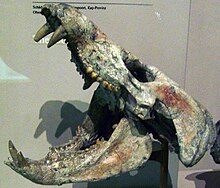Gomphodontia
| Gomphodonts Temporal range: Early - Late Triassic,
| |
|---|---|

| |
| Skull of the gomphodont Diademodon tetragonus | |
| Scientific classification | |
| Domain: | Eukaryota |
| Kingdom: | Animalia |
| Phylum: | Chordata |
| Clade: | Synapsida |
| Clade: | Therapsida |
| Clade: | Cynodontia |
| Clade: | †Cynognathia |
| Clade: | †Gomphodontia Seeley, 1895 |
| Subgroups | |
| |
Gomphodontia is a clade of cynognathian cynodonts that includes the families Diademodontidae, Trirachodontidae, and Traversodontidae. Gomphodonts are distinguished by wide and closely spaced molar-like postcanine teeth, which are convergent with those of mammals. Other distinguishing characteristics of gomphodonts include deep zygomatic arches, upper postcanines with three or more cusps spanning their widths and lower postcanines with two cusps spanning their widths.[2] They are thought to have been herbivorous or omnivorous.[3] Gomphodonts first appeared in the Early Triassic and became extinct at the end of the Late Triassic. Fossils are known from southern Africa, Argentina and southern Brazil (Paleorrota geopark), eastern North America, Europe, China, and Antarctica.
Gomphodontia was first named by paleontologist Harry Seeley in 1895.[4] He considered it an order of wide-toothed therapsids (then called anomodonts) from South Africa, distinct from Cynodontia. By the 1930s Gomphodontia was considered a suborder of Cynodontia and included the families Diademodontidae, Trirachodontidae, Traversodontidae, and Tritylodontidae.[5] These four families have also been grouped in the superfamily Traversodontoidea, named by paleontologist Edward Drinker Cope in 1884. Tritylodontoidea has occasionally replaced Gomphodontia in various cynodont taxonomies. In 2001 Gomphodontia was defined as a stem-based clade including all cynodonts more closely related to Exaeretodon than to Cynognathus.[6] This placed it within the larger clade Cynognathia, one of the two main groups of eucynodonts (the other being Probainognathia). Since then most studies have removed Tritylodontidae from Gomphodontia and reclassified it within Probainognathia as a group more closely related to mammals than are the convergently similar gomphodonts. Tritylodontoidea has fallen into disuse while Gomphodontia continues to be used in many studies.
Cladogram
Below is a cladogram from Ruta, Botha-Brink, Mitchell and Benton (2013) showing one hypothesis of gomphodont relationships:[7]
| Cynognathia |
| ||||||
References
- ^ Hendrickx, C.; Gaetano, L. C.; Choiniere, J. N.; Mocke, H.; Abdala, F. (2020). "A new traversodontid cynodont with a peculiar postcanine dentition from the Middle/Late Triassic of Namibia and dental evolution in basal gomphodonts". Journal of Systematic Palaeontology. 18 (20): 1669–1706. doi:10.1080/14772019.2020.1804470. S2CID 221838726.
- ^ Sues, H. D.; Hopson, J. A. (2010). "Anatomy and phylogenetic relationships of Boreogomphodon jeffersoni (Cynodontia: Gomphodontia) from the Upper Triassic of Virginia". Journal of Vertebrate Paleontology. 30 (4): 1202. doi:10.1080/02724634.2010.483545. S2CID 85793070.
- ^ Hendrickx, Christophe; Abdala, Fernando; Choiniere, Jonah N. (2019-06-13). "A proposed terminology for the dentition of gomphodont cynodonts and dental morphology in Diademodontidae and Trirachodontidae". PeerJ. 7: e6752. doi:10.7717/peerj.6752. ISSN 2167-8359. PMC 6571134. PMID 31223521.
- ^ Seeley, H. G. (1895). "Researches on the Structure, Organization, and Classification of the Fossil Reptilia. Part IX., Section 4. On the Gomphodontia". Philosophical Transactions of the Royal Society of London B. 186: 1–57. doi:10.1098/rstb.1895.0001. JSTOR 91793.
- ^ Parrington, F.R. (1936). "On the Tooth-Replacement in Theriodont Reptiles". Philosophical Transactions of the Royal Society of London B: Biological Sciences. 226 (532): 121–142. doi:10.1098/rstb.1936.0005. JSTOR 92294.
- ^ Hopson, J.A.; Kitching, J.W. (2001). "A probainognathian cynodont from South Africa and the phylogeny of nonmammalian cynodonts". Bulletin of the Museum of Comparative Zoology. 156 (1): 5–35.
- ^ Ruta, M.; Botha-Brink, J.; Mitchell, S. A.; Benton, M. J. (2013). "The radiation of cynodonts and the ground plan of mammalian morphological diversity". Proceedings of the Royal Society B: Biological Sciences. 280 (1769): 20131865. doi:10.1098/rspb.2013.1865. PMC 3768321. PMID 23986112.

